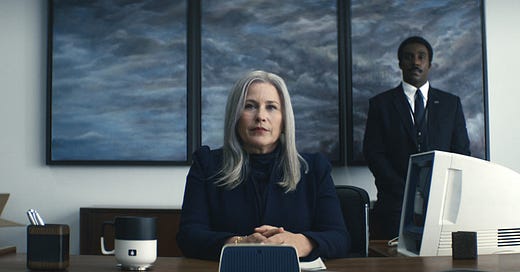“The good news is Hell is just the product of a morbid human imagination. The bad news is whatever humans can imagine they can usually create.”
- Harmony Cobell, Severed Floor Manager, Lumon Industries, in Severance, Episode 01-01, Good News About Hell
I begin the post with a quote from the pilot episode of Severance, AppleTV’s latest prestige addition to the workplace TV genre, as I struggle to shake the highly produced 4k imagery of CECOT, the deadly Salvadoran forced labor and death camp from which the current regime claims there is no return.
If you’re someone who thinks about the relations between workers and bosses and how labor relations shape society, the show is rich source of insight and investigation.
People familiar with the past decade of ICE detention labor litigation will recognize that it’s not just in fictional TV where “innies” find themselves performing “voluntary” labor because they have no other alternative. This labor occurs under the noses of many well-meaning “outies” precisely because so few people actually know what goes on inside. That’s by design.
As ICE and its contractors inflict “horror movie” conditions on unsuspecting tourists and strive to reopen judicially declared “Hell Hole” facilities, we would do well to remember that not all the news about Hell is bad.
Occasionally light escapes the darkness, showing us all it hides. When this happens, it’s vital that those of use who want to see these places vanquished from human existence draw others’ attention there. So, with these thoughts (and that brilliant Severance theme music) in mind, here’s some Good News About Hell.
Detained Workers Keep Winning
A federal judge in the Northern District of New York denied an ICE detention contractor’s bid to throw out detained workers’ forced labor, wage theft, and unjust enrichment claims against the Alaska Native tribal corporation that operates the federally owned Batavia facility in Buffalo New York for profit. The court also certified a class of at least 5,000 detained immigrant workers, allowing the case to proceed at trial on behalf everyone imprisoned and forced to work there going back nearly a decade.
The same week, the U.S. District Court for the Middle District of Georgia allowed formerly incarcerated immigrant workers at the notorious Irwin County Detention Center in Ocilla, Georgia to proceed with their forced labor, unjust enrichment, and Alien Tort Statute claims against LaSalle, the company that actually profited from their labor, rather than one of the company’s many judgment-proof shell corporations/liability shields. As the decision makes clear, jurisdictional discovery demonstrated the corporate structure extracting Irwin detainees’ labor resembled the one 30 Rock’s Jack Donaghy proposed for manufacturing and marketing Tracy Jordan’s Meat Machine (“Meat is the new bread! Aragh!”).
The Irwin forced labor class action is led by a timeless and historically consequently detention warrior and ICEbreaker, Nilson Barahona, among several others. As Jack Donaghy would say of those who like Phil Collins, Nilson’s story resonates with anyone who’s “got two ears and a heart.” If you haven’t watched The Facility, I highly recommend it. I’d also encourage anyone with the means and desire to directly support the ICEBreakers organizing collective ($ICEbreakers2021 on zelle and cashapp).
These court decisions mark yet another high point in a monumental series of wins by the Innies for the Innies. As I recently shared with Berkeley Law Students during a conversation with current and formerly detained workers in a Northern California ICE facility, the coercive extraction of labor and violent retaliation to its resistance by imprisoned laborers is part of the DNA of all carceral systems in the U.S. That DNA animated the trans-Atlantic slave trade and the ongoing genocide of indigenous peoples on Turtle Island. Its legacy lives on with us. So too does the resistance to it.
Plenary power — the right to decide who gets to have rights — is extraconstitutional fascism. It is a universal acid: once it’s introduced into a system, it will burn through everything until there’s nothing left, eventually eating itself. (See, for example, the recent sidelining of plenary power’s chief legal defender for at least the past decade, Erez Reuveni.) Yet this made-up doctrine is so deeply entrenched in our judge-made law that, if I were a betting man, I’d bet the Supreme Court lets deportees rot in CECOT before disturbing it. And if all of this analysis is correct, it means there’s really nothing people can ultimately do with the law itself to dislodge the usurpers, because we have, as the genociders used to tell the Court, until the Court said it itself, “No rights which the White man is bound to respect.”
I’ll be doing a video breaking down the latest forced labor case decisions soon, as they merit further exploration. For now, I’d like to leave you with the words of the man who spoke to young lawyers from inside a his government-imposed cage, because it’s exactly what the Severance procedure—and our current carceral paradigm—seeks to prevent Innies and Outies alike from doing.
“Before judging, put yourself in our shoes.”




